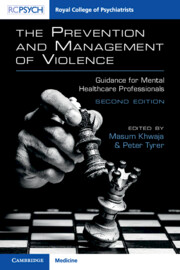Book contents
- The Prevention and Management of Violence
- The Prevention and Management of Violence
- Copyright page
- Dedication
- Contents
- Contributors
- Preface
- Abbreviations
- Section 1 General Aspects of Management
- Section 2 Medical and Psychological Intervention
- Section 3 Violence in Different Settings
- Section 4 Management in Other Groups
- Introduction to Section 4
- Chapter 13 Working With Violence in Children: A Developmental and Relational Perspective
- Chapter 14 Management of Violence in Older Adults
- Chapter 15 Management of Violence in People With Intellectual Disability
- Chapter 16 The Relationship Between Violence and Mental Health Inequality in the Black, Asian and Minority Ethnic Communities
- Section 5 Violence and Society
- Section 6 Engagement and Understanding
- Index
- References
Chapter 14 - Management of Violence in Older Adults
from Section 4 - Management in Other Groups
Published online by Cambridge University Press: 09 May 2023
- The Prevention and Management of Violence
- The Prevention and Management of Violence
- Copyright page
- Dedication
- Contents
- Contributors
- Preface
- Abbreviations
- Section 1 General Aspects of Management
- Section 2 Medical and Psychological Intervention
- Section 3 Violence in Different Settings
- Section 4 Management in Other Groups
- Introduction to Section 4
- Chapter 13 Working With Violence in Children: A Developmental and Relational Perspective
- Chapter 14 Management of Violence in Older Adults
- Chapter 15 Management of Violence in People With Intellectual Disability
- Chapter 16 The Relationship Between Violence and Mental Health Inequality in the Black, Asian and Minority Ethnic Communities
- Section 5 Violence and Society
- Section 6 Engagement and Understanding
- Index
- References
Summary
Violence from older adults is a challenge for healthcare services. Risk factors include those common to working-age adults, namely substance misuse, active psychotic symptoms and inadequate care, and those more typical in older age, including cognitive impairment, acute confusion and pain. Aggression is a barrier to good care and a challenge to manage in older adults who are more vulnerable to medication effects and side effects. Medications must be used with caution. Prevention of violence through sensitive person-centred care and management of risk factors is recommended, as is non-pharmacological management. Here, we review management through non-pharmacological and pharmacological measures.
- Type
- Chapter
- Information
- The Prevention and Management of ViolenceGuidance for Mental Healthcare Professionals, pp. 234 - 247Publisher: Cambridge University PressPrint publication year: 2023



